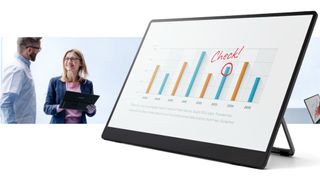This exciting wireless portable monitor shows what future tablets could look like
Turn every Android tablet into a wireless monitor

Ricoh has unveiled a portable monitor that looks to stand out from a very crowded market thanks to one unique selling point - it can mirror content from another device (tablet, smartphone, desktop PC or laptop) wirelessly.
According to Nikkei Asia, Ricoh teamed up with a Tokyo-based startup formed by ex-Sharp employees and called Team S to develop a technology called SSE (Smart Streaming Engine) which appears to be a two-way version of Miracast with a latency of 100ms, enough for day-to-day productivity tasks (video conferencing, browsing, office work) but probably not low enough for gaming.
The 150BW portable monitor turns into an interactive display similar to a standard tablet with a 15.6-inch diagonal and weighs only 715 grams. There’s no need for extra apps as the tablet syncs directly with the smartphone (we’re unsure as to whether it is screen mirroring and if it can be used with a locked device).
The monitor doesn’t come cheap though at around $690 in Japan, making it a potential candidate for those looking for a business monitor on the move.
These monitors could essentially replace smartphones
Physically, the device has a big bezel with a full HD OLED panel, a kickstand and a built-in 3.74Ah battery. There’s also a pair of speakers and two USB connectors, as users can connect via a USB Type-C cable. Up to five displays can be connected to a single device at the same time (although one will be touch-enabled).
The Ricoh 150BW is also compatible with active stylus pens, making it ideal for graphic designers or indeed anyone that wants to digitize handwritten input. The Nikkei report concludes with the very optimistic hope that “Further development of the technology, coupled with high-speed 5G networks, could pave the way for these monitors to essentially replace smartphones.”
Team S is apparently working on the concept of a virtual smartphone in the cloud for later this year, something that sounds puzzling. Isn’t this - in essence - a tablet version of a thin-client with a virtual desktop located in a data center somewhere?
Are you a pro? Subscribe to our newsletter
Sign up to the TechRadar Pro newsletter to get all the top news, opinion, features and guidance your business needs to succeed!
Beyond that lofty ambition though is the real possibility that Team S could license the technology to tablet makers like Huawei or Samsung and other portable monitor manufacturers (LG, Viewsonic) so that they turn tablets into portable monitors and vice versa, without the need for any third party applications.
- Check out the best monitor for photo editing
- Read our guide of the best monitor for programming
- These are the best monitors for video editing

Désiré has been musing and writing about technology during a career spanning four decades. He dabbled in website builders and web hosting when DHTML and frames were in vogue and started narrating about the impact of technology on society just before the start of the Y2K hysteria at the turn of the last millennium.
Most Popular

